Roosevelt Theodore ââåa Laymanã¢ââ¢s Views of an Art Exhibitionã¢ââ 29 March 1913
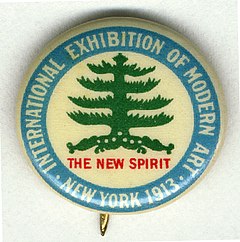 Armory evidence push button, 1913 | |
| Engagement | Feb 17, 1913 (1913-02-17) to March 15, 1913 (1913-03-fifteen) |
|---|---|
| Location | 69th Regiment Armory, New York, NY |
| Also known every bit | The International Exhibition of Mod Art |
| Participants | Artists in the Armory Show |

The 1913 Arsenal Prove, also known as the International Exhibition of Mod Fine art, was a show organized past the Association of American Painters and Sculptors in 1913. It was the first big exhibition of modern art in America, every bit well as one of the many exhibitions that take been held in the vast spaces of U.S. National Baby-sit armories.
The 3-metropolis exhibition started in New York City'south 69th Regiment Arsenal, on Lexington Avenue betwixt 25th and 26th Streets, from Feb 17 until March 15, 1913.[1] The exhibition went on to the Art Institute of Chicago then to The Copley Club of Art in Boston,[ii] where, due to a lack of space, all the piece of work by American artists was removed.[iii]
The show became an important result in the history of American art, introducing astonished Americans, who were accustomed to realistic art, to the experimental styles of the European avant garde, including Fauvism and Cubism. The prove served as a catalyst for American artists, who became more independent and created their own "artistic language."
The origins of the testify lie in the emergence of progressive groups and independent exhibitions in the early 20th century (with significant French precedents), which challenged the aesthetic ideals, exclusionary policies, and say-so of the National Academy of Design, while expanding exhibition and sales opportunities, enhancing public knowledge, and enlarging audiences for contemporary art.[4]
History [edit]
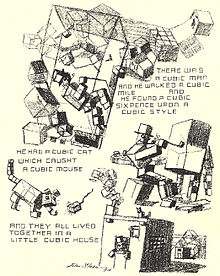
A cartoon by John French Sloan titled "A slight attack of third dimentia brought on by excessive study of the much-talked of cubist pictures in the International Exhibition at New York", April 1913.


Exhibition organizer Walter Pach, circa 1909
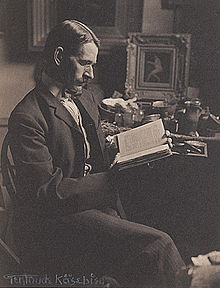
Exhibition organizer Arthur B. Davies, circa 1908
On Dec 14, 1911 an early on meeting of what would become the Clan of American Painters and Sculptors (AAPS) was organized at Madison Gallery in New York. Four artists met to discuss the contemporary art scene in the United States, and the possibilities of organizing exhibitions of progressive artworks by living American and foreign artists, favoring works ignored or rejected by electric current exhibitions. The meeting included Henry Fitch Taylor, Jerome Myers, Elmer Livingston MacRae and Walt Kuhn.[5]
In Jan 1912, Walt Kuhn, Walter Pach, and Arthur B. Davies joined together with some ii dozen of their colleagues to reinforce a professional coalition: AAPS. They intended the organization to "lead the public sense of taste in fine art, rather than follow it."[6] Other founding AAPS members included D. Putnam Brinley, Gutzon Borglum, John Frederick Mowbray-Clarke, Leon Dabo, William J. Glackens, Ernest Lawson, Jonas Lie, George Luks, Karl Anderson, James East.Fraser, Allen Tucker, and J. Alden Weir.[6] AAPS was to exist dedicated to creating new exhibition opportunities for young artists outside of the existing academic boundaries, besides as to providing educational art experiences for the American public.[1] Davies served equally president of AAPS, with Kuhn acting as secretary.[ commendation needed ]
The AAPS members spent more than a yr planning their first projection: the International Exhibition of Modern Art, a bear witness of behemothic proportions, unlike any New York had seen. The 69th Regiment Armory was settled on as the main site for the exhibition in the spring of 1912, rented for a fee of $v,000, plus an additional $500 for additional personnel.[7] It was confirmed that the show would subsequently travel to Chicago and Boston.[ citation needed ]
In one case the infinite had been secured, the most complicated planning task was selecting the art for the show, particularly after the determination was made to include a large proportion of vanguard European work, almost of which had never been seen by an American audience.[one] In September 1912, Kuhn left for an extended collecting tour through Europe, including stops at cities in England, Germany, the netherlands, and France, visiting galleries, collections and studios and contracting for loans as he went.[8] While in Paris Kuhn met upward with Pach, who knew the art scene there intimately, and was friends with Marcel Duchamp and Henri Matisse; Davies joined them in that location in November 1912.[ane] Together they secured three paintings that would end upward being amid the Armory Testify's most famous and polarizing: Matisse's Blue Nude (Gift de Biskra) and Madras Rouge (Ruby Madras Headdress), and Duchamp's Nude Descending a Staircase, No. 2. Only subsequently Davies and Kuhn returned to New York in December did they issue an invitation for American artists to participate.[1]
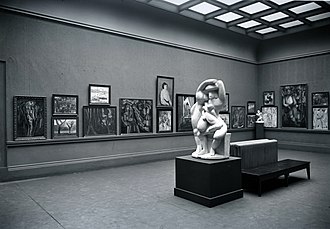
Armory Testify, Chicago, 1913. The Cubist room
Pach was the only American artist to exist closely affiliated with the Section d'Or group of artists, including Albert Gleizes, Jean Metzinger, Duchamp brothers Marcel Duchamp, Raymond Duchamp-Villon, Jacques Villon and others. Pach was responsible for securing loans from these painters for the Armory Show. Nigh of the artists in Paris who sent works to the Armory Show knew Pach personally and entrusted their works to him.[9]
The Armory Evidence was the first, and ultimately the only exhibition mounted by the AAPS. Information technology displayed some 1,300 paintings, sculptures, and decorative works by over 300 avant-garde European and American artists. Impressionist, Fauvist, and Cubist works were represented.[10] The publicity that stormed the prove had been well sought, with the publication of half-tone postcards of 57 works, including the Duchamp nude that would become its most infamous.[11] News reports and reviews were filled with accusations of quackery, insanity, immorality, and anarchy, likewise equally parodies, caricatures, doggerels, and mock exhibitions. Some responded with laughter, as the artist John French Sloan seemed to non have the exhibition seriously in his published cartoon, "A slight assail of third dimentia brought on by excessive report of the much-talked of cubist pictures in the International Exhibition at New York".[12] Nearly the modernistic works, former President Theodore Roosevelt declared, "That's not fine art!"[thirteen] The civil authorities did not, notwithstanding, close down or otherwise interfere with the show.[ commendation needed ]
Among the scandalously radical works of art, pride of place goes to Marcel Duchamp's cubist/futurist style Nude Descending a Staircase, painted the year before, in which he expressed motion with successive superimposed images, as in motion pictures. Julian Street, an art critic, wrote that the work resembled "an explosion in a shingle mill" (this quote is likewise attributed to Joel Spingarn[14]), and cartoonists satirized the slice. Gutzon Borglum, i of the early organizers of the prove who for a diverseness of reasons withdrew both his organizational prowess and his work, labeled this piece A staircase descending a nude, while J. F. Griswold, a writer for the New York Evening Sunday, entitled it The rude descending a staircase (Blitz hour in the subway).[15] The painting was purchased from the Armory Bear witness past Frederic C. Torrey of San Francisco.[16]
The buy of Paul Cézanne's Hill of the Poor (View of the Domaine Saint-Joseph) by the Metropolitan Museum of Fine art signaled an integration of modernism into the established New York museums, but among the younger artists represented, Cézanne was already an established master.[ citation needed ]
Duchamp's brother, who went past the "nom de guerre" Jacques Villon, also exhibited, sold all his Cubist drypoint etchings, and struck a sympathetic chord with New York collectors who supported him in the following decades.[ citation needed ]
The exhibition went on to testify at the Fine art Found of Chicago and then to The Copley Social club of Art in Boston,[2] where, due to a lack of infinite, all the work past American artists was removed.[3]
While in Chicago, the exhibition created a scandal that reached the governor's office. Several articles in the press recounted the issue. In i paper the headline read: Cubist Art Will be Investigated; Illinois Legislative Investigators to Probe the Moral Tone of the Much Touted Fine art:
Chicago, April two: Charges that the international exhibition of cubist and futurist pictures, now beingness displayed hither at the art institute, contains many indecent canvasses and sculptures will be investigated at once past the Illinois legislature white slave committee. A visit of an investigator to the testify and his written report on the pictures acquired Lieutenant Governor Barratt O'Hara to gild an immediate examination of the entire exhibition. Mr. O'Hara sent the investigator to look over the pictures later he had received many complaints of the character of the bear witness. "Nosotros volition non condemn the international showroom without an impartial investigation," said the lieutenant governor today. "I have received many complaints, however, and we owe it to the public that the bailiwick be looked into thoroughly." The investigator reported that a number of the pictures were "immoral and suggestive." Senators Woodward and Beall of the commission will visit the exhibition today.
— Ottumwa Tri-Weekly Courier, Iowa, 3 Apr 1913[17]
Floor plan [edit]

The following shows the content of each gallery:[18]
- Gallery A: American Sculpture and Decorative Fine art
- Gallery B: American Paintings and Sculpture
- Gallery C, D, E, F: American Paintings
- Gallery G: English, Irish and German Paintings and Drawings
- Gallery H, I: French Painting and Sculpture
- Gallery J: French Paintings, Water Colors and Drawings
- Gallery K: French and American Water Colors, Drawings, etc.
- Gallery 50: American Water Colors, Drawings, etc.
- Gallery Grand: American Paintings
- Gallery N: American Paintings and Sculpture
- Gallery O: French Paintings
- Gallery P: French, English language, Dutch and American Paintings
- Gallery Q: French Paintings
- Gallery R: French, English and Swiss Paintings
Legacy [edit]
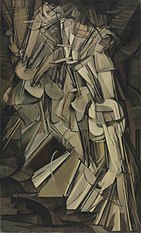

The original exhibition was an overwhelming success. In that location take been several exhibitions that were celebrations of its legacy throughout the 20th century.[19]
In 1944 the Cincinnati Art Museum mounted a smaller version, in 1958 Amherst College held an exhibition of 62 works, 41 of which were in the original show, and in 1963 the Munson-Williams-Proctor Arts Institute in Utica, New York organized the "1913 Arsenal Show 50th Anniversary Exhibition" sponsored by the Henry Street Settlement in New York, which included more than than 300 works.[19]
Experiments in Art and Technology (Eastward.A.T.) was officially launched by the engineers Billy Klüver and Fred Waldhauer and the artists Robert Rauschenberg and Robert Whitman when they collaborated in 1966 and together organized ix Evenings: Theatre and Engineering science, a series of performance fine art presentations that united artists and engineers. Ten artists worked with more thirty engineers to produce art performances incorporating new applied science. The performances were held in the 69th Regiment Armory, as an homage to the original and historical 1913 Armory show.[xx] [21]
In Feb 2009, the Art Dealers Clan of America (ADAA) presented its 21st almanac Fine art Bear witness to benefit the Henry Street Settlement, at the Seventh Regiment Armory, located betwixt 66th and 67th Streets and Park and Lexington Avenues in New York City. The exhibition began as a historical homage to the original 1913 Armory Show.[ commendation needed ]
Starting with a minor exhibition in 1994, by 2001 The Armory Show, at present held at the Javits Center, evolved into a "hugely entertaining" (The New York Times) almanac gimmicky arts festival with a potent commercial bent.[ commendation needed ]
Commemorating the centennial [edit]
Many exhibitions in 2013 celebrated the 100th ceremony of the 1913 Armory Bear witness, as well as a number of publications, virtual exhibitions, and programs. The start exhibition, "The New Spirit: American Art in the Armory Testify, 1913," opened at the Montclair Fine art Museum on February 17, 2013, a hundred years to the day from the original.[one] The 2d exhibition was organized by the New-York Historical Order and titled "The Armory Evidence at 100," taking place from October 18, 2013 through February 23, 2014.[22] The Smithsonian's Athenaeum of American Art, which lent dozens of historic documents to both the New York Historical Guild and Montclair for the exhibitions, created an online timeline of events, 1913 Armory Evidence: the Story in Chief Sources, to showcase the records and documents created by the bear witness's organizers.[23]
Showing contemporary work, a third exhibition, The Fountain Art Fair, was held at the 69th Regiment Armory itself during the 100th anniversary during March 8–ten, 2013. The ethos of Fountain Art Fair was inspired by Duchamp's famous "Fountain" which was the symbol of the Fair.[24] The Fine art Constitute of Chicago, which was the only museum to host the 1913 Armory Show, presented works Feb twenty – May 12, 2013, the items drawn from the museum's modern collection that were displayed in the original 1913 exhibition.[25] The DePaul Art Museum in Chicago, Illinois presented For and Against Modern Art: The Armory Testify +100, from April 4 to June 16, 2013.[26] The International Print Center in New York held an exhibition, "1913 Armory Show Revisited: the Artists and their Prints," of prints from the prove or by artists whose work in other media was included.[11]
In addition, the Greenwich Historical Gild presented The New Spirit and the Cos Cob Art Colony: Earlier and After the Armory Prove, from October nine, 2013, through January 12, 2014. The evidence focused on the effects of the Armory Evidence on the Cos Cob Art Colony, and highlighted the involvement of artists such as Elmer Livingston MacRae and Henry Fitch Taylor in producing the show.[27]
American filmmaker Michael Maglaras produced a documentary picture show virtually the Armory Show entitled, The Great Confusion: The 1913 Arsenal Bear witness. The film premiered on September 26, 2013, at the New Great britain Museum of American Fine art in New Britain, Connecticut.[28]
List of artists [edit]
Beneath is a partial list of the artists in the evidence. These artists are all listed in the 50th anniversary catalog as having exhibited in the original 1913 Arsenal show.[19]
- Robert Ingersoll Aitken
- Alexander Archipenko
- George Grey Barnard
- Chester Beach
- Gifford Aggravate
- Maurice Becker
- George Bellows
- Joseph Bernard
- Guy Pène du Bois
- Oscar Bluemner
- Hanns Bolz
- Pierre Bonnard
- Solon Borglum
- Antoine Bourdelle
- Constantin Brâncuși
- Georges Braque
- Bessie Marsh Brewer
- Patrick Henry Bruce
- Paul Burlin
- Theodore Earl Butler
- Charles Camoin
- Arthur Carles
- Mary Cassatt
- Oscar Cesare
- Paul Cézanne
- Robert Winthrop Chanler
- Pierre Puvis de Chavannes
- John Frederick Mowbray-Clarke
- Nessa Cohen
- Camille Corot
- Kate Cory
- Gustave Courbet
- Henri-Edmond Cross
- Leon Dabo
- Andrew Dasburg
- Honoré Daumier
- Jo Davidson
- Arthur B. Davies (President)
- Stuart Davis
- Edgar Degas
- Eugène Delacroix
- Robert Delaunay
- Maurice Denis
- André Derain
- Katherine Sophie Dreier
- Marcel Duchamp
- Georges Dufrénoy
- Raoul Dufy
- Jacob Epstein
- Mary Foote
- Roger de La Fresnaye
- Othon Friesz
- Paul Gauguin
- William Glackens
- Albert Gleizes
- Vincent van Gogh
- Francisco Goya
- Marsden Hartley
- Childe Hassam
- Robert Henri
- Edward Hopper
- Ferdinand Hodler
- Jean Auguste Dominique Ingres
- James Dickson Innes
- Augustus John
- Gwen John
- Wassily Kandinsky
- Ernst Ludwig Kirchner
- Leon Kroll
- Walt Kuhn (Founder)
- Gaston Lachaise
- Marie Laurencin
- Ernest Lawson
- Henri de Toulouse-Lautrec
- Arthur Lee
- Fernand Léger
- Wilhelm Lehmbruck
- Jonas Prevarication
- George Luks
- Aristide Maillol
- Édouard Manet
- Henri Manguin
- Edward Middleton Manigault
- John Marin
- Albert Marquet
- Henri Matisse
- Alfred Henry Maurer
- Kenneth Hayes Miller
- David Milne
- Claude Monet
- Adolphe Monticelli
- Edvard Munch
- Ethel Myers
- Jerome Myers (Founder)
- Elie Nadelman
- Olga Oppenheimer
- Walter Pach
- Jules Pascin
- Francis Picabia
- Pablo Picasso
- Camille Pissarro
- Maurice Prendergast
- Odilon Redon
- Pierre-Auguste Renoir
- Boardman Robinson
- Theodore Robinson
- Auguste Rodin
- Georges Rouault
- Henri Rousseau
- Morgan Russell
- Albert Pinkham Ryder
- André Dunoyer de Segonzac
- Georges Seurat
- Charles Sheeler
- Walter Sickert
- Paul Signac
- Alfred Sisley
- John Sloan
- Amadeo de Souza Cardoso
- Joseph Stella
- Felix E. Tobeen
- John Henry Twachtman
- Félix Vallotton
- Raymond Duchamp-Villon
- Jacques Villon
- Maurice de Vlaminck
- Bessie Potter Vonnoh
- Édouard Vuillard
- Abraham Walkowitz
- J. Alden Weir
- James Abbott McNeill Whistler
- Enid Yandell
- Jack B. Yeats
- Mahonri Immature
- Marguerite Zorach
- William Zorach
List of women artists [edit]
Women artists in the Armory Prove includes those from the U.s.a. and from Europe. Approximately a fifth of the artists showing at the arsenal were women, many of whom have since been neglected.[29]
Images [edit]

A list written in 1912 by Pablo Picasso of European artists he felt should be included in the 1913 Armory Show. This document dispels the exclamation that an unbridgeable divide separated the Salon Cubists from the Gallery Cubists. Walt Kuhn family papers and Armory Show records, Athenaeum of American Fine art, Smithsonian Institution.
-

Entrance of the Exhibition, 1913, New York Urban center
-

Interior view of the exhibition, 1913, New York City
-
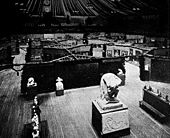
Interior view of the exhibition, 1913, New York City
-
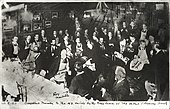
Armory Evidence artists and members of the press at the beefsteak dinner given by the Association of American Painters and Sculptors, March 8, 1913. Percy Rainford, photographer. Walt Kuhn family papers and Armory Prove records, Athenaeum of American Art, Smithsonian Institution
-
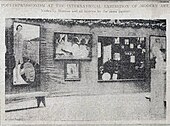
Installation shot of the Matisse room, 1913 Armory Show, published in the New York Tribune (p. 7), February 17, 1913. From the left: Le Luxe 2, 1907–08, Statens Museum for Kunst, Copenhagen; "Blue Nude (Souvenir de Biskra)", 1907, Baltimore Museum of Art; L'Atelier Rouge, 1911, Museum of Modern Art, New York City
-

Installation shot of the Cubist room, published in the New York Tribune, Feb 17, 1913 (p. 7). Left to right: Raymond Duchamp-Villon, La Maison Cubiste (Projet d'Hotel), Cubist House; Marcel Duchamp Nude (Study), Deplorable Beau on a Train; Albert Gleizes, Fifty'Homme au Balcon, Human being on a Balustrade; Marcel Duchamp, Nude Descending a Staircase, No. two; Alexander Archipenko, La Vie Familiale, Family Life
Selected painting and sculpture [edit]
-

Mary Cassatt, Mère et enfant (Reine Lefebre and Margot earlier a Window), c.1902
-

-
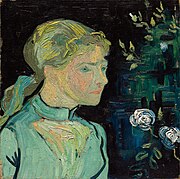
-

-

Paul Gauguin, Nature morte à l'estampe japonaise (Flowers Against a Yellow Groundwork), 1889, oil on sail, 72.4 × 93.7 cm, Museum of Gimmicky Art, Tehran
-

Henri Rousseau, Cheval attaqué par un jaguar (Jaguar Attacking a Equus caballus), 1910, oil on canvas, 116 ten xc cm, Pushkin Museum
-

-

-
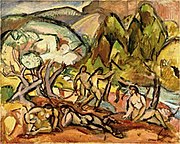
Othon Friesz, Landscape with Figures, 1909, oil on canvas, 65 × 83 cm
-
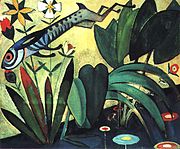
-

Robert Winthrop Chanler, Leopard and Deer, 1912, gouache or tempera on canvass, mounted on wood, 194.3 × 133.4 cm, Rokeby Collection
-

-
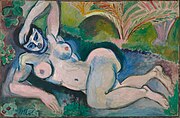
-

-

Pablo Picasso, 1910, Woman with Mustard Pot (La Femme au pot de moutarde), oil on sheet, 73 x 60 cm, Gemeentemuseum, The Hague
-

-

-

-

Francis Picabia, Grimaldi après la pluie (believed to be Souvenir of Grimaldi, Italy), ca. 1912, location unknown
-
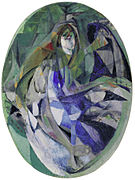
Jacques Villon, 1912, Daughter at the Piano (Fillette au piano), oil on canvas, 129.2 x 96.4 cm, oval, Museum of Mod Art, New York. Exhibited at the 1913 Arsenal Show, New York, Chicago and Boston. Purchased from the Arsenal Show by John Quinn
-

Aristide Maillol, Bas Relief, terracotta. Exhibited at the 1913 Armory Show, New York, Chicago, Boston. Catalogue image (no. 110)
-

Alexander Archipenko, La Vie Familiale (Family Life), 1912. Exhibited at the 1912 Salon d'Automne, Paris and the 1913 Armory Show in New York, Chicago and Boston. The original sculpture (approx six feet tall) was accidentally destroyed
-
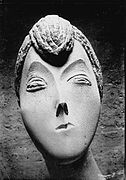
Constantin Brâncuși, 1909, Portrait De Femme (La Baronne Renée Frachon), now lost. Armory Show, published press clipping, 1913
-
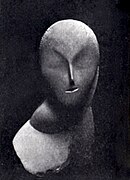
Constantin Brâncuși, Une Muse, 1912, plaster, 45.7 cm (xviii in.) Armory Show postcard. Exhibited: New York (no. 618); The Art Institute of Chicago (no. 26) and Boston, Copley Hall (no. viii)
-

Wilhelm Lehmbruck, 1911, Femme á genoux (The Kneeling One), bandage stone, 176 × 138 × lxx cm, Armory Prove postcard
-

Jacob Epstein, The Rock Drill, 1913, in its original course, it is at present lost.
Special installation [edit]
La Maison Cubiste (Cubist Business firm) [edit]

Raymond Duchamp-Villon, 1912, Study for La Maison Cubiste, Projet d'Hotel (Cubist House), plaster, H. 3 meters past W. 10 meters. Image published in Les Peintres Cubistes, by Guillaume Apollinaire, March 17, 1913
At the 1912 Salon d'Automne an architectural installation was exhibited that quickly became known equally Maison Cubiste (Cubist House), signed Raymond Duchamp-Villon and André Mare along with a grouping of collaborators. Metzinger and Gleizes in Du "Cubisme", written during the assemblage of the "Maison Cubiste", wrote about the autonomous nature of art, stressing the point that decorative considerations should not govern the spirit of art. Decorative work, to them, was the "antonym of the moving picture". "The true picture" wrote Metzinger and Gleizes, "bears its raison d'être within itself. It can be moved from a church building to a drawing-room, from a museum to a written report. Substantially contained, necessarily complete, it demand not immediately satisfy the mind: on the contrary, it should atomic number 82 information technology, niggling past little, towards the fictitious depths in which the coordinative calorie-free resides. It does not harmonize with this or that ensemble; it harmonizes with things in general, with the universe: it is an organism...".[30] "Mare'south ensembles were accustomed as frames for Cubist works because they allowed paintings and sculptures their independence", writes Christopher Green, "creating a play of contrasts, hence the interest not only of Gleizes and Metzinger themselves, but of Marie Laurencin, the Duchamp brothers (Raymond Duchamp-Villon designed the facade) and Mare's old friends Léger and Roger La Fresnaye".[31] La Maison Cubiste was a fully furnished house, with a staircase, wrought iron banisters, a living room—the Salon Bourgeois, where paintings past Marcel Duchamp, Metzinger (Adult female with a Fan), Gleizes, Laurencin and Léger were hung—and a bedroom. It was an example of L'art décoratif, a dwelling within which Cubist art could be displayed in the condolement and manner of modern, bourgeois life. Spectators at the Salon d'Automne passed through the full-calibration x-by-three-meter plaster model of the ground floor of the facade, designed by Duchamp-Villon.[32] This architectural installation was afterward exhibited at the 1913 Arsenal Testify, New York, Chicago and Boston,[33] listed in the catalogue of the New York showroom as Raymond Duchamp-Villon, number 609, and entitled "Facade architectural, plaster" (Façade architecturale).[34] [35]
Sources [edit]
- Sarah Douglas. "Pier Pressure." March 26, 2008. Archived on April 11, 2008.
- Catalogue of International Exhibition of Modern Art, at the Armory of the Lx-Ninth Infantry, Feb xv to March 15, 1913. Association of American Painters and Sculptors, 1913.
- Walt Kuhn. The Story of the Armory Prove. New York, 1938.
- Milton Westward. Dark-brown. The Story of the Armory Show. Joseph H. Hirshhorn Foundation, distributed past New York Graphic Gild, 1963. [republished by Abbeville Press, 1988.]
- 1913 Arsenal Show 50th Anniversary Exhibition. Text by Milton W. Brown. Utica: Munson-Williams-Proctor Institute, 1963.
- Walter Pach Papers, Archives of American Art, Smithsonian Establishment
- Walt Kuhn, Kuhn Family Papers, and Arsenal Show Records, Archives of American Art, Smithsonian Institution
See besides [edit]
- Listing of artists in the Armory Show
- List of women artists in the Armory Show
- Experiments in Art and Technology
- American modernism
- American realism
- Ashcan school
- Culture of New York City
- The Armory Bear witness (art fair)
References [edit]
- ^ a b c d due east f Cotter, Holland (October 28, 2012). "Rethinking the Armory Show". The New York Times. p. i.
- ^ a b International Exhibition of Modern Art, catalogue embrace, Copley Society of Boston, Copley Hall, Boston, Mass., 1913
- ^ a b Dark-brown, Milton W., The Story of the Arsenal Evidence, Joseph H Hirshhorn Foundation, New York, 1963, pp. 185–186
- ^ Berman, Avis (2000). As National as the National Biscuit Company; The Academy, the Critics, and the Armory Show, Rave Reviews American Fine art and Its Critics, 1826–1925. New York: National Academy of Design. p. 131.
- ^ 1913 Arsenal Show, The Story in Main Sources (Timeline)
- ^ a b "New York Arsenal Testify of 1913". AskArt.com. Retrieved February 1, 2013.
- ^ "Securing a Infinite: The 69th Regiment Arsenal". 1913 Armory Show: the Story in Master Sources. Archives of American Art, Smithsonian Institution. Retrieved February one, 2013.
- ^ "Walt Kuhn'southward Itinerary through Europe, 1912". 1913 Arsenal Show: the Story in Chief Sources. Archives of American Art, Smithsonian Institution. Retrieved Feb 1, 2013.
- ^ Laurette E. McCarthy, Walter Pach, Walter Pach (1883–1958), The Arsenal Show and the Untold Story of Modern Art in America, Penn State Press, 2011
- ^ McShea, Megan, A Finding Help to the Walt Kuhn Family Papers and Armory Show Records, 1859–1978 (majority 1900–1949), Archives of American Art, Smithsonian Institution.
- ^ a b Andress, Sarah. "1913 Armory Show Revisited: The Artists and their Prints," Art in Print Vol. iii No. ii (July–August 2013).
- ^ Blanke, David. The 1910s. Greenwood Publishing Group, 2002. p. 275. ISBN 9780313312519
- ^ Theodore Roosevelt's review of the Arsenal Evidence for The Outlook, published on March 29, 1913, was entitled "A Layman'due south View of an Art Exhibition". See Edmund Morris, Colonel Roosevelt (Random House, New York, 2010; ISBN 978-0-375-50487-vii), pages 267–272 and 660–663. According to Morris, Roosevelt's review looked with some favor upon the new American artists.
- ^ Joel Spingarn, p. 110
- ^ Brown, Milton W., The Story of the Arsenal Show, Joseph H Hirshhorn Foundation, New York, 1963, p. 110
- ^ xroads. Univ. of Virginia
- ^ Cubist Fine art Will be Investigated; Illinois legislative Investigators to Probe the Moral Tone of the Much Touted Fine art, Ottumwa Tri-Weekly Courier (Ottumwa, Iowa), three April 1913. Chronicling America: Historic American Newspapers. Lib. of Congress
- ^ "Gallery Map". Academy of Virginia. Retrieved February sixteen, 2018.
- ^ a b c 1913 Armory Testify 50th Anniversary Exhibition 1963 copyright and organized by Munson-Williams-Proctor Arts Institute, copyright and sponsored by the Henry Street Settlement, New York City, Library of Congress card number 63-13993
- ^ Vehicle, online. Retrieved September 25, 2008.
- ^ documents, history online. Retrieved September 25, 2008.
- ^ "The Armory Show at 100". New-York Historical Society. Retrieved February 1, 2013.
- ^ "1913 Armory Show: The Story in Primary Sources". Archives of American Art, Smithsonian Institution. Retrieved February ane, 2013.
- ^ "Fountain Fine art Fair". Retrieved Feb 24, 2013.
- ^ "Celebrating the Armory Show". Retrieved March 12, 2013.
- ^ "Armory Prove". Retrieved March 12, 2013.
- ^ Greenwich Historical Order
- ^ "Earth Premier Film Event: The Slap-up Confusion: The 1913 Armory Testify". Connecticut Magazine. Connecticutmag.com. 2013.
- ^ Shircliff, Jennifer Pfeifer (May 2014). Women of the 1913 Arsenal Show: Their Contributions to the Evolution of American Modern Art. Louisville, Kentucky: University of Louisville. Retrieved November 15, 2014.
- ^ "Albert Gleizes and Jean Metzinge, except from Du Cubisme, 1912" (PDF). Archived from the original (PDF) on June ii, 2013. Retrieved Apr fifteen, 2013.
- ^ Christopher Greenish, Art in France: 1900–1940, Affiliate eight, Modern Spaces; Modern Objects; Mod People, 2000
- ^ La Maison Cubiste, 1912 Archived March thirteen, 2013, at the Wayback Machine
- ^ Kubistische werken op de Armory Show
- ^ Duchamp-Villon'due south Façade architecturale, 1913
- ^ "Catalogue of international exhibition of modern fine art: at the Arsenal of the Sixty-ninth Infantry, 1913, Duchamp-Villon, Raymond, Facade Architectural
External links [edit]
| External video | |
|---|---|
| @ The Museum of Modern Art, New York City | |
| |
1913 Armory Show [edit]
- The Armory Testify at 100: Modern Art and Revolution, The New-York Historical Society
- Smithsonian, Archives of American Art, Walt Kuhn scrapbook of press clippings documenting the Armory Show, vol. two, 1913. Armory Evidence catalogue (illustrated) from pages 159 through 236
- Catalogue of international exhibition of modern fine art Association of American Painters and Sculptors. Published 1913 by the Clan in New York
- 1913 Arsenal Evidence: the Story in Primary Sources, Athenaeum of American Art, Smithsonian Institution
- Virtual re-creation of the Armory Show from the American Studies Programs at the University of Virginia
- Works of art exhibited at the Arsenal Show of the association of American Painters and Sculptors, New York, Library of Congress
- The Arsenal Testify at 100: Armory Prove 1913 Complete Listing, The New-York Historical Society
Armory shows later 1913 [edit]
- The "New" Armory Evidence
- Artkrush.com feature on the 2006 Armory Show (March, 2006)
- 2010 Armory Show
- Swann Galleries – The Armory Prove at 100 – Exhibition through November 5, 2013
- Armory Show 2014: List of exhibiting galleries
Coordinates: twoscore°44′29″N 73°59′03″W / 40.74139°N 73.98417°W / 40.74139; -73.98417
adamsonfivereclums.blogspot.com
Source: https://en.wikipedia.org/wiki/Armory_Show

0 Response to "Roosevelt Theodore ââåa Laymanã¢ââ¢s Views of an Art Exhibitionã¢ââ 29 March 1913"
Post a Comment